Making noise to make some music.
Here’s a musical entry from my cabinet of curiosities.
I’m a 7 on the Enneagram. In brief: I’m always looking for adventure, afraid of being stuck, and always planning the next project.
This translates into many unfinished projects.
So, I vowed recently as we went into lockdown that I wouldn’t start any new projects until I finish my backlog. Felt like an ambitious goal, but I knew it was important for me to stop being so scattered.
Jack of all trades, master of none and all that.
One of the projects on my list for many years was a cigar box guitar. I had already commissioned a 3-string because I found a vintage cigar box I really didn’t want to mess up.
But I wanted to make one myself.
How hard could it be?
I quit smoking anything decades ago because I started racing triathlons and I always hated the aftertaste. Still, I always appreciated the designs on the boxes and labels of cigars. The rough construction, the typography, the handmade feel.
Plus, the quality boxes are made of nice cedar wood. I already had all of the parts, and just never got around to building it out.
I bought a Fuente Fuente OpusX Belicoso cigar box back in 2012. I intended to make a guitar. A six string. I even bought a guitar neck to install.
Well, eight years later all I’d done with it was stored some bonsai tools in the box.

I sat down to plan all the parts and quickly discovered that the salvaged guitar neck wouldn’t fit properly because it had just been an impulse buy, unmeasured, unplanned. At least I was able to take the tuners from it.
Project Pivot
Another thing I’ve been doing over these lockdown months is working with my son to help him learn to play ukulele. And, well, I had always wanted to learn to play as well!
I measured the box and found that it would be the perfect size for a concert ukulele.
I loved building airplane models as a kid. But I always built them raw. I never had the patience to paint the parts piece-by-piece before assembly. And I usually wanted to be finished all in one sitting. As you can imagine, I had lots of planes — in the unadorned plastic. Glue everywhere.
Decades later, I’m finally learning to plan out my projects (a bit more) and have the patience to go step-by-step.
I opted with a pre-machined neck and fretboard because although I have optimism bias, I am at least sober enough to realize I have neither the skills nor the tools for crafting a uke neck from a wood block.

I thought the fretboard would be already attached to the neck.
Nope.
In fact, it appeared that the neck was too wide for the fretboard by half an inch on both sides (You can see above in the photo). So, I sanded both sides down by hand as close as I could to match the fretboard’s width.
Usually, fretboards are left with a kind of tail that extends on to the body of the instrument, primarily decorative because people rarely play all the way up there (except if you’re Jake Shimabukuru). I decided to shorten the fretboard because I want the option to open the body again in the future if I want to add a piezo element pickup for amplification.
Curves Ahead
When I went to attach the neck to the body, I realized that the box edges are more curved than I realized. That meant the neck would jut off the bottom, because it had a straight edge.
So, I sanded that down to add a slight curve in the neck joint. I taped a piece of sandpaper to the curve and ran the flat side of the neck until it fit.
I think I probably could have gotten away with gluing the neck and bridge in, but I was worried the tension from the strings might warp the neck joint. Also, the cigar box has a nice protective layer of varnish and stain on the surface, which I was worried might lessen the bond of the wood glue.
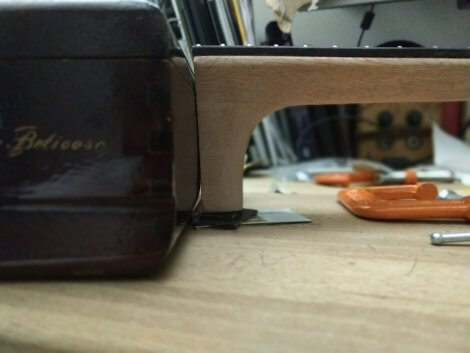
Too curvy
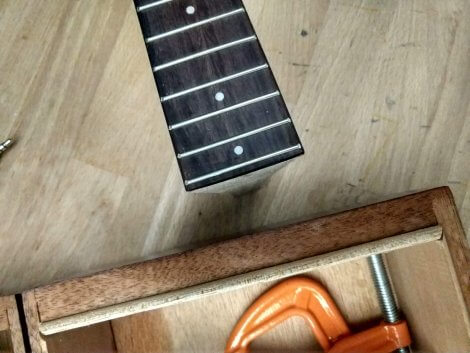
I masked the areas off before applying the glue. What’s great about this cigar box is that it’s thick and sturdy.
At first, I had planned to just rely on the screw for the bridge and neck, but I was kind of paranoid that there might be too much stress, so I glued and screwed.
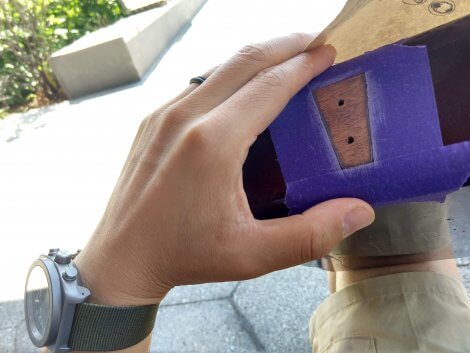
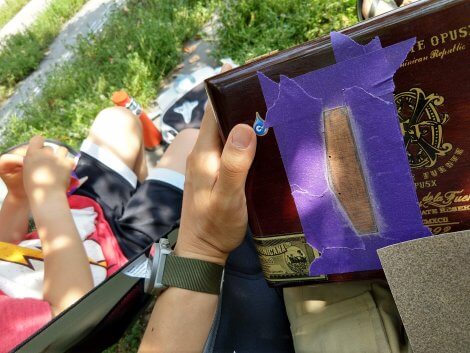
Scout Donated His Purple Tape Because Scout Hates Purple And Won’t Use It
Tangent: Fuente Fuente OpusX Belicoso?
I was curious what kind of cigars came in this box.
Turns out there’s a really interesting backstory to Arturo Fuente, a family business that makes these cigars. Cigar aficionados “highly covet” these Fuente Fuente OpusX cigars because some say they’re even better than Cubans. They took a big risk over 20 years ago and are the only cigar maker in the Dominican Republic that grow a Cuban leaf used to wrap cigars.
That explained why the boxes were so nice. The name of these cigars is an interesting mashup of meanings:
- Fuente Fuente: Fountain/Source (Twice — to symbolize bond between father and son).
- OpusX: Large scale important composition by a composer. (The founder added X because then it sounded like ‘sex’ — haha, savvy marketer. (Checkout the details on the label made in the Netherlands).
- Bellicoso: Warlike
/end tangent.
The box held additional wood insert sidewalls. So, I didn’t need to add any reinforcements for attaching the neck, because they’re already there.
For the bridge, even though the lid is thick, I wanted to distribute the tension across the lid. I pulled out one of the wood trimmings from the sides — which wasn’t functional — and glued it to the area beneath the bridge.
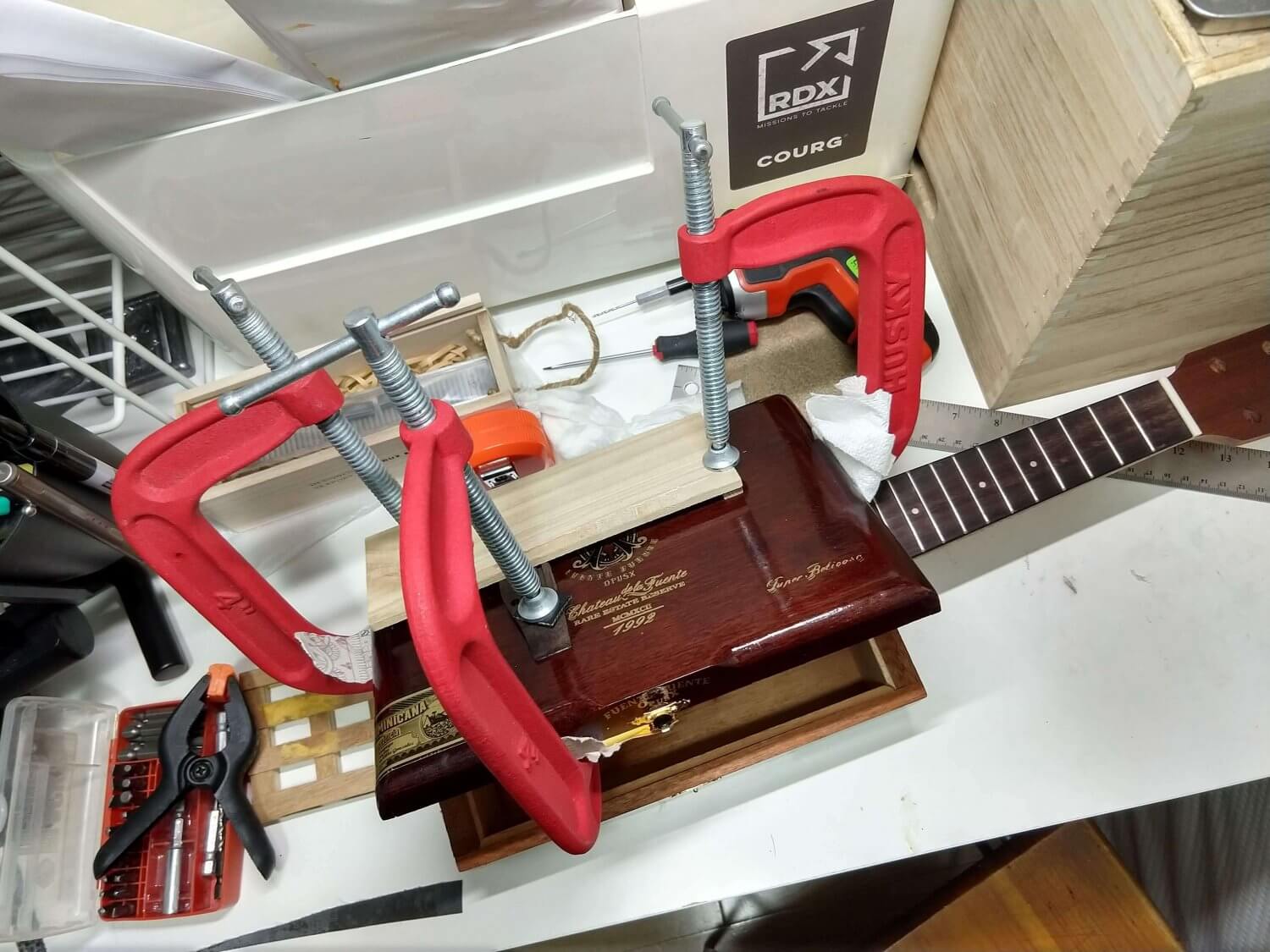
The project required creative clamping because I don’t have any of the fancy wood clamps and don’t foresee needing those for other projects any time soon.
Sound Hole Dilemma
I thought and sketched for a week about what I wanted to do about the sound hole. I wanted something distinctive, not just one traditional single hole. But I also had to work within my woodworking limitations.
I worried I wouldn’t be able to make the avocado or other non-traditional shapes as well as I’d like. And maybe I’d get sick of an odd shape — or worse, ruin the box.
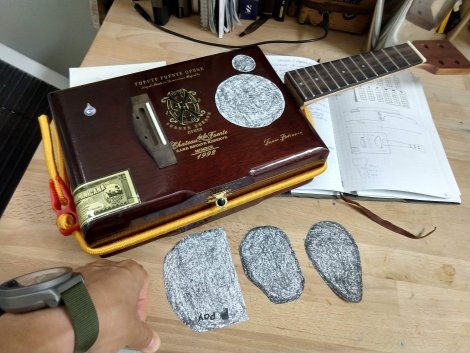
Sound Hole Shape Candidates
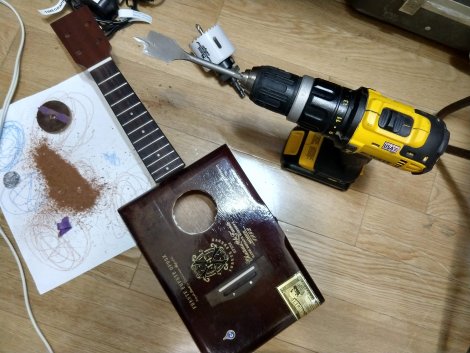
In the end, I went with a traditional circular sound hole with an added offset hole to hopefully open up the sound more. A bit of research didn’t reveal anything definitive about sound quality except tests with violin shaped holes, which I entertained for about one minute.
I borrowed a 2.5 inch bit and a 1 inch drill bit from my friend. The drill bits wobbled a bit and were not exactly straight. But I did my best to go slowly and stabilize the bits. You can see the 1 inch hole is a bit irregular.

Ukulele Sound Holes, Rough
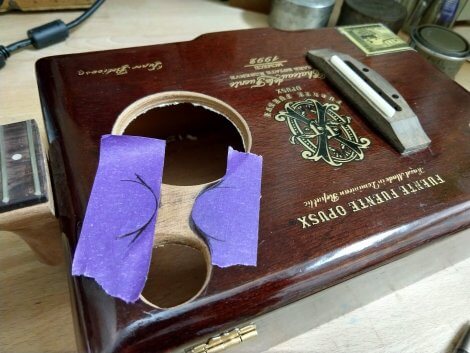
Ukulele Sound Hole, Refinement
I ended up with little piles of cedar and the cedar smells so good. It’s amazing how fragrant the wood smells even after almost a decade in my closet. I might have to make some cedar candles.
I didn’t want to add any varnish to the sound holes in case I wanted to edit them in the future. So, I used some wood oil to seal it up for now.
 To finish the Fuente OpusX, I chose some black string, and didn’t feel like fussing with tying knots on the bridge because I was eager to see if it would actually play and stay in tune! Next time I replace the strings, I’ll probably tie the knots though since the little beads aren’t great-looking.
To finish the Fuente OpusX, I chose some black string, and didn’t feel like fussing with tying knots on the bridge because I was eager to see if it would actually play and stay in tune! Next time I replace the strings, I’ll probably tie the knots though since the little beads aren’t great-looking.
Overall, I’m pleased with the ukulele and enjoy its mellow sound. Maybe as mellow as the smoke some cigar aficionados enjoy — just without the after-stench.
And instead, every once in a while I catch a woody musky gorgeous scent of cedar.
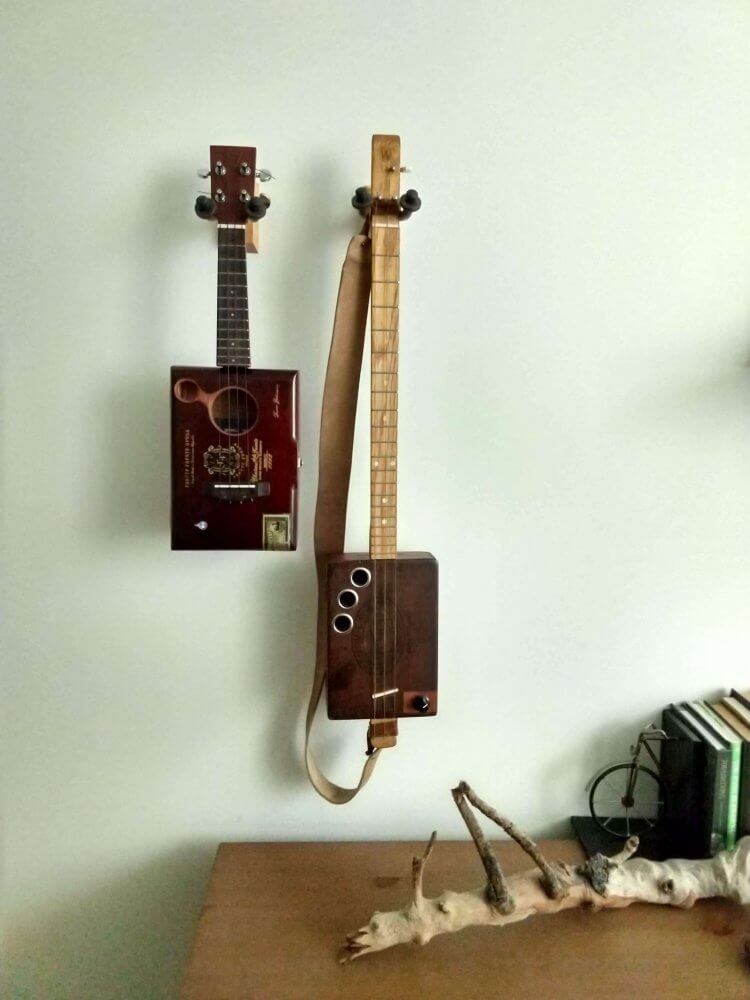
Cigar Box Ukulele and Guitar
(I’m not sure exactly where I found this PDF, I can’ track down the original URL. But I found some helpful tips, and skipped bits I didn’t need in this build. I’ll leave it here in case you’re looking for more technical and legit instructions for making your own: How to Make a Cigar Box Ukulele by Steven Miller)
